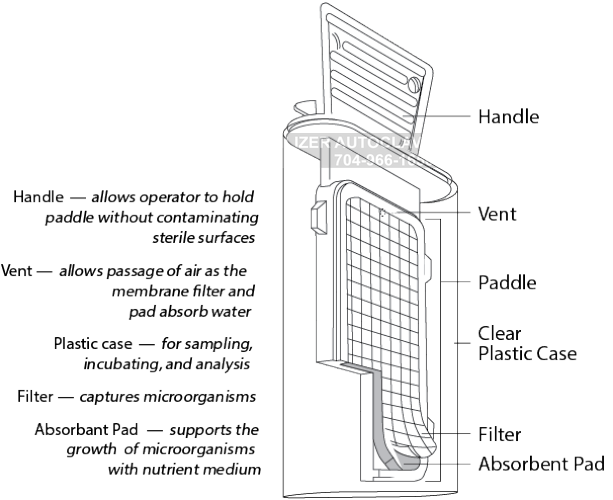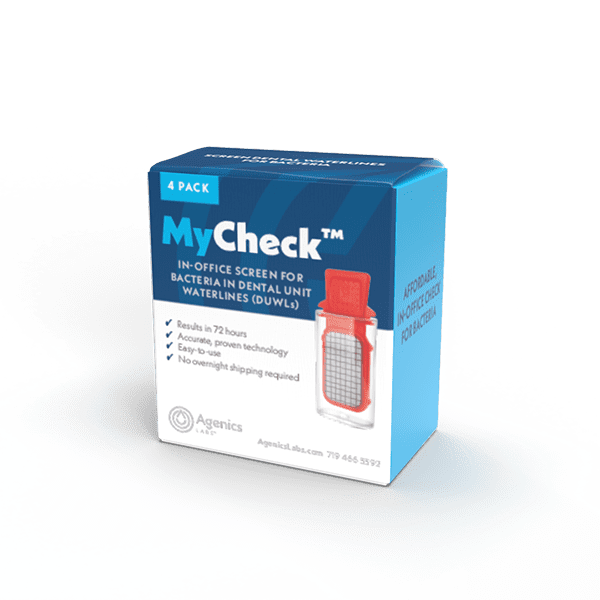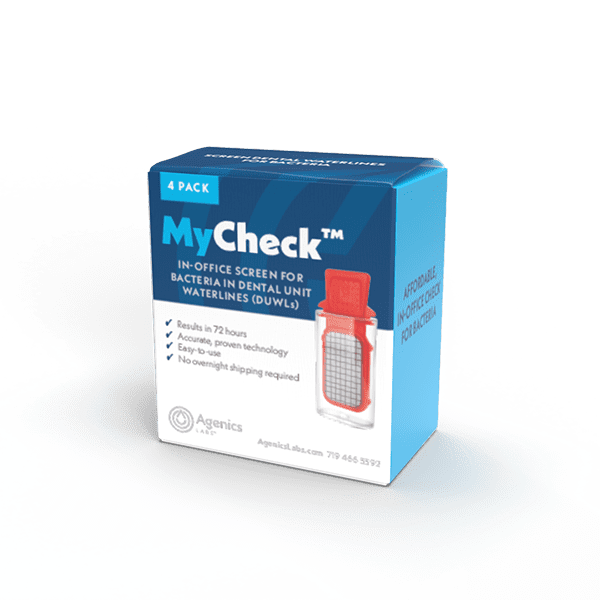MyCheck In-office Waterline Test Kit, 4/Pkg
MyCheck In-office Waterline Test Kit, 4/Pkg
SKU:MC-4
Couldn't load pickup availability
MyCheck is an in-office dental waterline testing kit that screens dental unit waterlines for bacteria and provides an estimated heterotrophic plate count (HPC) to indicate probable compliance with the CDC & EPA guidelines of ≤500CFU/mL.
- Provides an estimated HPC bacteria number
- Easy to use
- Results in 72 hours
The convenient MyCheck is a self-contained paddle tester that is individually packaged, sterilized, and ready to use. The HPC DUWL sampler includes: A plastic paddle, an air vent on the back of the paddle, a membrane filter, a plastic case for sampling and incubating, instructions for use, and a sample log.
How You Test
It’s easier than you might think

STEP ONE: PREPARING TO COLLECT THE SAMPLE
- Flush waterlines for 20-30 seconds
- Remove handpieces, syringe tips and/or insert from the ultrasonic scaler
STEP TWO: COLLECTING THE SAMPLE
- Use one paddle for each chair to be sampled. Water can be collected from one line or many lines so long as it’s from the same chair
- Remove the MyCheck Sampler from the plastic bag.
- Use a black Sharpie to label the clear sample collection container with the date and sampling location. (e.g., room, doctor, or assistant cart).
- Remove the red paddle from the plastic container. DO NOT put the paddle down, keep it in your hand facing away from your palm.
- Place the container into the fluid stream and fill the plastic container to the fill line. Do not touch the outlet of the waterline or the interior of the collection container.
- Insert the red paddle into the filled plastic case and lay it horizontal, with the filter-side down.
- Wait 30 seconds (timed with a watch) for fluid to be drawn through the filter.
- Remove the paddle from the case and discard the water.
- Shake the paddle to remove residual water; then, being careful not to touch the paddle or membrane surface, firmly reinsert the paddle into the plastic case for incubation.
NOTE: The filter will appear dark in color after being exposed to water. This is normal and not an indicator of high bacterial content.
STEP THREE: INCUBATING
Incubate MyCheck with the filter-side down at a temperature of 75± 2°F (room temperature) for 72 hours.
STEP FOUR: EXAMINING THE FILTER
After the incubation period has elapsed, remove the paddle from the case and examine the filter under bright sunlight.
The microbial colonies will appear as spots on the filter. Their appearance will vary, depending upon the microorganisms recovered. Generally, colonies are glistening and either translucent or transparent. Colors vary from colorless to white, cream, yellow, gray, or red. Sizes range from 5 mm to pinpoint. Edges may be smooth and rounded or rough and irregular.
STEP FIVE: COUNTING COLONIES
- Count each colony, or spot, growing on the filter as a representative of an individual micro- organism. Count all the colonies, regardless of size, color, or shape.
- Use the grid lines on the filter to help you count. Follow a pattern of counting, such as scanning from left to right across one row of gridlines, then down to the next row, and across the row from right to left. Some colonies will grow on the grid lines. To avoid counting these colonies twice, establish a pattern.
- If the DUWL contains microorganism counts greater than 300 CFU/ mL many of the colonies may grow together on the filter, making them difficult to count.
- In addition, the accuracy of such a count may be called into question. The count on such a filter is recorded as “too numerous to count” or TNTC.
- Refer to the Colony Counting Chart
STEP SIX: DISPOSAL OF MYCHECK
Dispose of the HPC Sampler per local regulations for disposing of biohazardous waste. Prior to disposal, decontaminate it by autoclaving, incinerating, or treating with bleach solution (1:10 diluted household bleach in water for at least 30 minutes).


